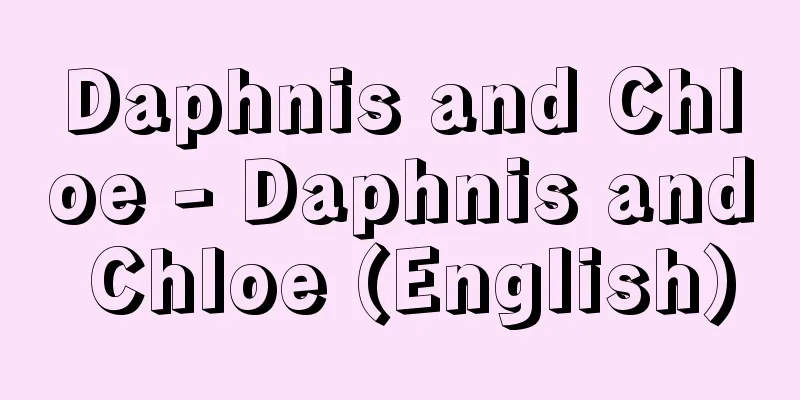Daphnis and Chloe - Daphnis and Chloe (English)

|
An ancient Greek love story. It is said to have been written by Longus around the 2nd century. It consists of four volumes. It is set in the countryside on the Aegean island of Lesbos. A foundling boy is picked up by a goatherd and raised as Daphnis. About two years later, a girl who had been abandoned on a neighboring farm is found by the shepherd and named Chloe. As they grow up, the two fall in love with each other and share an innocent kiss, but their peaceful rural life through the seasons is thrown into turmoil when Daphnis is nearly kidnapped by pirates and Chloe is taken away by the enemy in war. Chloe is narrowly rescued, but then another suitor appears and they face various crises, but in the end, evidence proves that Daphnis is the son of a respectable farmer and Chloe is a girl of good social standing, and the two are happily united. This work has many elements in common with ancient stories, but the setting is uniform, and the underlying pastoral atmosphere gives it a unique flavor not seen in other contemporary novels. It has been widely read and loved by modern people, including Goethe, and has had the greatest influence on later generations of all ancient novels, including the ballet music of the same name by Ravel and Saint-Pierre's novel "Paul et Virginie." [Masatoshi Hikiji] BalletThis story was adapted into a dance by Diaghilev of the Russian Ballet, and French composer Ravel was commissioned to compose music for it. The piece premiered in Paris in 1912, conducted by Pierre Monteux, with choreography by Fokine and starring Nijinsky and Karsavina. Ravel's music is not simply for ballet, but rather a symphonic poem that makes full use of a variety of orchestral techniques, and two concert suites were composed from it. The first suite premiered in 1911, earlier than the ballet, and the second in 1913. [Yukio Miyake] "Daphnis and Chloe" translated by Go Shigeichi (included in World Literature Series 64, 1961, Chikuma Shobo) Source: Shogakukan Encyclopedia Nipponica About Encyclopedia Nipponica Information | Legend |
|
古代ギリシアの恋愛小説。2世紀ごろロンゴスが書いたと伝えられる。全四巻。舞台はエーゲ海のレスボス島の田舎(いなか)。山羊(やぎ)飼いに拾われた捨て子の男の子がダフニスの名で育てられ、2年ほどのち、今度は隣の牧場に捨てられていた女の子が羊飼いにみつけられ、クロエと名づけられる。成長した2人は互いに想(おも)いを寄せ、あどけない口づけを交わすようになるが、平和な田園の四季の生活に波瀾(はらん)が起こり、ダフニスが海賊にさらわれそうになったり、戦争で敵がクロエを連れ去ったりする。危うく助けられたクロエに、今度は別の求婚者が現れ、さまざまの危機があるが、結局ダフニスは証拠の品からりっぱな農園主の息子であり、クロエも身分のよい娘であることが判明し、2人はめでたく結ばれる。この作品には古代の物語に共通する要素も多いが、舞台に統一性があり、基調となる牧歌的雰囲気など、他の同時代の小説にはみられない独自の味をもっている。ゲーテをはじめとして近代にも広く愛読され、同名のラベルのバレエ音楽やサン・ピエールの小説『ポールとビルジニー』など、古代の小説のなかでは後世に与えた影響がもっとも大きい。 [引地正俊] バレエこの物語は、ロシア・バレエ団のディアギレフによって舞踊化され、フランスの作曲家ラベルに音楽を依頼、1912年パリで、ピエール・モントゥー指揮、フォーキンの振付け、ニジンスキーとカルサビナの主演で初演された。ラベルの音楽は、単なるバレエ用というよりも、むしろ多彩な管弦楽法を駆使した交響詩とでもよぶべきものであり、これから演奏会用の組曲が二つ編まれている。第一組曲はバレエより早く1911年に、第二組曲は13年に初演された。 [三宅幸夫] 『呉茂一訳『ダフニスとクロエー』(『世界文学大系64』所収・1961・筑摩書房)』 出典 小学館 日本大百科全書(ニッポニカ)日本大百科全書(ニッポニカ)について 情報 | 凡例 |
>>: Taft-Hartley Act - Taft-Hartley Act
Recommend
Shoni Sukeyoshi
Year of death: 4th year of Koan, 7th year of leap ...
Oroshimachiku - Oroshimachiku
... The main horticultural varieties of Nezasa in...
Amagi Kyuuboku
...Strawberry cultivation in rice paddies in nort...
Cupule
〘 noun 〙 A cup-shaped or spherical organ that enca...
Fischart, Johann
Born: 1546. Strasbourg Died: 1590. Forbach. German...
Barrows, HH (English spelling) BarrowsHH
… Almost in parallel with sociology, a movement t...
Post-operative bleeding
When an area that has already bled due to an injur...
bokmål (English spelling) bokmal
...However, a separate language, Landsmål, was fo...
Dog run - Inubashiri
An architectural term. Originally meaning a space...
Periodic table of contents (English spelling)
…His philosophical stance is evident in Problems ...
Okinawa grasshopper - Okinawa grasshopper
...Hokkaido is home to the very similar G. ussuri...
Pressure ratio
… [Compressor performance] The capacity of a comp...
Inoue Nissho
Leader of a right-wing terrorist group. His real ...
Hinshelwood, CN (English spelling) HinshelwoodCN
…The study of elementary reactions began with Ern...
Node - Fushi
〘noun〙① The part of a plant trunk or stem that is ...









